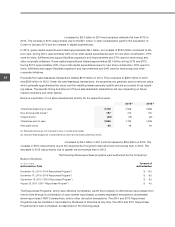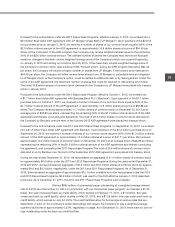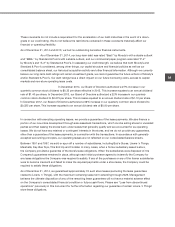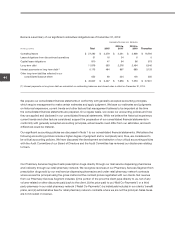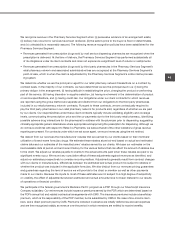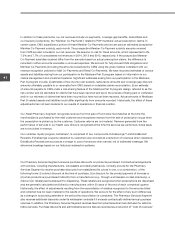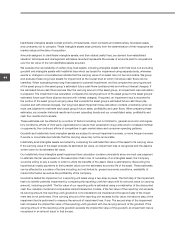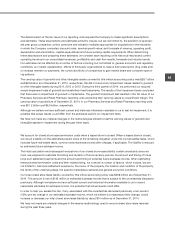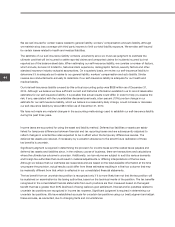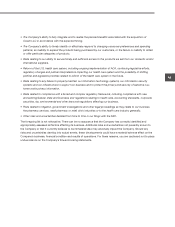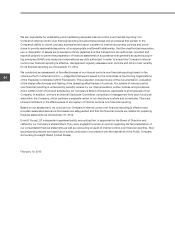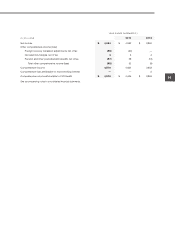CVS 2014 Annual Report Download - page 45
Download and view the complete annual report
Please find page 45 of the 2014 CVS annual report below. You can navigate through the pages in the report by either clicking on the pages listed below, or by using the keyword search tool below to find specific information within the annual report.
43
2014 Annual Report
Retail Pharmacy Segment
Vendor allowances received by the Retail Pharmacy Segment reduce the carrying cost of inventory and are
recognized in cost of revenues when the related inventory is sold, unless they are specifically identified as a reim-
bursement of incremental costs for promotional programs and/or other services provided. Amounts that are directly
linked to advertising commitments are recognized as a reduction of advertising expense (included in operating
expenses) when the related advertising commitment is satisfied. Any such allowances received in excess of the
actual cost incurred also reduce the carrying cost of inventory. The total value of any upfront payments received
from vendors that are linked to purchase commitments is initially deferred. The deferred amounts are then amortized
to reduce cost of revenues over the life of the contract based upon purchase volume. The total value of any upfront
payments received from vendors that are not linked to purchase commitments is also initially deferred. The deferred
amounts are then amortized to reduce cost of revenues on a straight-line basis over the life of the related contract.
We have not made any material changes in the way we account for vendor allowances and purchase discounts
during the past three years.
Inventory
All prescription drug inventories in the Retail Pharmacy Segment have been valued at the lower of cost or market
using the weighted average cost method. The weighted average cost method is used to determine cost of sales and
inventory in our mail service and specialty pharmacies in our Pharmacy Services Segment. Front store inventory in
our Retail Pharmacy Segment is stated at the lower of cost or market on a first-in-first-out (“FIFO”) basis using the
retail method of accounting to determine cost of sales and inventory, and the cost method of accounting on a FIFO
basis to determine front store inventory in our distribution centers. Under the retail method, inventory is stated at
cost, which is determined by applying a cost-to-retail ratio to the ending retail value of our inventory. Since the retail
value of our front store inventory is adjusted on a regular basis to reflect current market conditions, our carrying
value should approximate the lower of cost or market. In addition, we reduce the value of our ending inventory for
estimated inventory losses that have occurred during the interim period between physical inventory counts. Physical
inventory counts are taken on a regular basis in each store and a continuous cycle count process is the primary
procedure used to validate the inventory balances on hand in each distribution center and mail facility to ensure that
the amounts reflected in the accompanying consolidated financial statements are properly stated. The accounting
for inventory contains uncertainty since we must use judgment to estimate the inventory losses that have occurred
during the interim period between physical inventory counts. When estimating these losses, we consider a number
of factors, which include, but are not limited to, historical physical inventory results on a location-by-location basis
and current physical inventory loss trends.
Our total reserve for estimated inventory losses covered by this critical accounting policy was $189 million as of
December 31, 2014. Although we believe we have sufficient current and historical information available to us to
record reasonable estimates for estimated inventory losses, it is possible that actual results could differ. In order to
help you assess the aggregate risk, if any, associated with the uncertainties discussed above, a ten percent (10%)
pre-tax change in our estimated inventory losses, which we believe is a reasonably likely change, would increase or
decrease our total reserve for estimated inventory losses by about $19 million as of December 31, 2014.
Although we believe that the estimates discussed previously are reasonable and the related calculations conform to
generally accepted accounting principles, actual results could differ from our estimates, and such differences could
be material.





